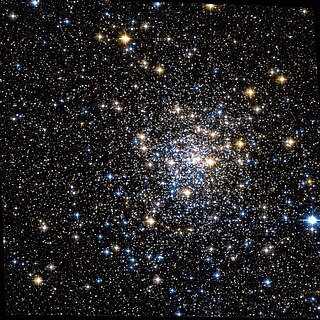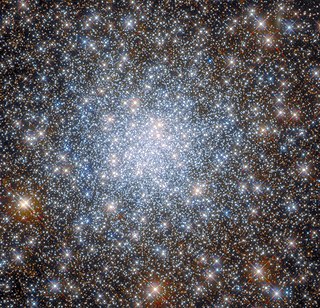
A globular cluster is a spheroidal conglomeration of stars that is bound together by gravity, with a higher concentration of stars towards their centers. They can contain anywhere from tens of thousands to many millions of member stars, all orbiting in a stable, compact formation. Globular clusters are similar in form to dwarf spheroidal galaxies, and the distinction between the two is not always clear. Their name is derived from Latin globulus. Globular clusters are occasionally known simply as "globulars".

RR Lyrae variables are periodic variable stars, commonly found in globular clusters. They are used as standard candles to measure (extra) galactic distances, assisting with the cosmic distance ladder. This class is named after the prototype and brightest example, RR Lyrae.

Messier 4 or M4 is a globular cluster in the constellation of Scorpius. It was discovered by Philippe Loys de Chéseaux in 1745 and catalogued by Charles Messier in 1764. It was the first globular cluster in which individual stars were resolved.

Messier 5 or M5 is a globular cluster in the constellation Serpens. It was discovered by Gottfried Kirch in 1702.

Messier 107 or M107, also known as NGC 6171 or the Crucifix Cluster, is a very loose globular cluster in a very mildly southern part of the sky close to the equator in Ophiuchus, and is the last such object in the Messier Catalogue.

Messier 3 is a globular cluster of stars in the northern constellation of Canes Venatici.

Messier 2 or M2 is a globular cluster in the constellation Aquarius, five degrees north of the star Beta Aquarii. It was discovered by Jean-Dominique Maraldi in 1746, and is one of the largest known globular clusters.

Messier 9 or M9 is a globular cluster in the constellation of Ophiuchus. It is positioned in the southern part of the constellation to the southwest of Eta Ophiuchi, and lies atop a dark cloud of dust designated Barnard 64. The cluster was discovered by French astronomer Charles Messier on June 3, 1764, who described it as a "nebula without stars". In 1783, English astronomer William Herschel was able to use his reflector to resolve individual stars within the cluster. He estimated the cluster to be 7–8′ in diameter with stars densely packed near the center.

Messier 19 or M19 is a globular cluster in the constellation Ophiuchus. It was discovered by Charles Messier on June 5, 1764 and added to his catalogue of comet-like objects that same year. It was resolved into individual stars by William Herschel in 1784. His son, John Herschel, described it as "a superb cluster resolvable into countless stars". The cluster is located 4.5° WSW of Theta Ophiuchi and is just visible as a fuzzy point of light using 50 mm (2.0 in) binoculars. Using a telescope with a 25.4 cm (10.0 in) aperture, the cluster shows an oval appearance with a 3′ × 4′ core and a 5′ × 7′ halo.

Messier 62 or M62, also known as NGC 6266 or the Flickering Globular Cluster, is a globular cluster of stars in the south of the equatorial constellation of Ophiuchus. It was discovered in 1771 by Charles Messier, then added to his catalogue eight years later.

Messier 92 is a globular cluster of stars in the northern constellation of Hercules.

NGC 5466 is a class XII globular cluster in the constellation Boötes. Located 51,800 light years from Earth and 52,800 light years from the Galactic Center, it was discovered by William Herschel on May 17, 1784, as H VI.9. This globular cluster is unusual insofar as it contains a certain blue horizontal branch of stars, as well as being unusually metal poor like ordinary globular clusters. It is thought to be the source of a stellar stream discovered in 2006, called the 45 Degree Tidal Stream. This star stream is an approximately 1.4° wide star lane extending from Boötes to Ursa Major.

NGC 5986 is a globular cluster of stars in the southern constellation of Lupus, located at a distance of approximately 34 kilolight-years from the Sun. It was discovered by Scottish astronomer James Dunlop on May 10, 1826. John L. E. Dreyer described it as, "a remarkable object, a globular cluster, very bright, large, round, very gradually brighter middle, stars of 13th to 15th magnitude". Its prograde–retrograde orbit through the Milky Way galaxy is considered irregular and highly eccentric. It has a mean heliocentric radial velocity of +100 km/s. The galacto-centric distance is 17 kly (5.2 kpc), which puts it in the galaxy's inner halo.

NGC 121 is a globular cluster of stars in the southern constellation of Tucana. It is the oldest globular cluster in the Small Magellanic Cloud (SMC), which is a dwarf satellite galaxy of the Milky Way. This cluster was first discovered by English astronomer John Herschel on September 20, 1835. The compiler of the New General Catalogue, Danish astronomer John Louis Emil Dreyer, described this object as "pretty bright, pretty small, little extended, very gradually brighter middle". The cluster is located at a distance of around 200,000 light-years (60 kpc) from the Sun.

NGC 4147 is the New General Catalogue identifier for a globular cluster of stars in the northern constellation of Coma Berenices. It was discovered by English astronomer William Herschel on March 14, 1784, who described it as "very bright, pretty large, gradually brighter in the middle". With an apparent visual magnitude of 10.7, it is located around 60,000 light years away from the Sun at a relatively high galactic latitude of 77.2°.

NGC 6441 is a globular cluster in the southern constellation of Scorpius. It was discovered by the Scottish astronomer James Dunlop on May 13, 1826, who described it as "a small, well-defined rather bright nebula, about 20″ in diameter". The cluster is located 5 arc minutes east-northeast of the star G Scorpii, and is some 43,000 light-years from the Sun.

NGC 5053 is the New General Catalogue designation for a globular cluster in the northern constellation of Coma Berenices. It was discovered by German-British astronomer William Herschel on March 14, 1784 and cataloged as VI-7. In his abbreviated notation, he described it as, "an extremely faint cluster of extremely small stars with resolvable nebula 8 or 10′ diameter, verified by a power of 240, beyond doubt". Danish-Irish astronomer John Louis Emil Dreyer reported in 1888 that the cluster appeared, "very faint, pretty large, irregular round shape, growing very gradually brighter at the middle".

NGC 6544 is a small globular cluster visible in the constellation Sagittarius. It is magnitude 7.5, diameter 1 arcminute. It is less than 1 degree southeast of Messier 8, the Lagoon Nebula.

NGC 6638 is a globular cluster in the constellation Sagittarius. It is magnitude 9.5 and diameter 2 arc minutes, class VI. It is a half degree east of Lambda Sagittarii. It is a member of the Milky Way.

NGC 6535 is a globular cluster of stars located at a distance of 22,200 light years from Earth in the equatorial constellation of Serpens, and is listed in the New General Catalogue. Its discovery is usually attributed to astronomer John Russell Hind in 1852, however Wolfgang Steinicke has uncovered evidence that William Herschel's first discovery was actually NGC 6535, which he observed on 24th August 1780.





















